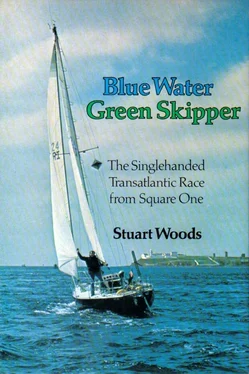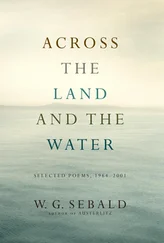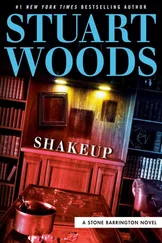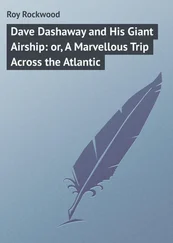Harry was arriving on Friday and we were sailing for Plymouth on Saturday. On Thursday night Ron and Laurel Holland arranged a farewell dinner at their new home in Currabinny; John and Diana McWilliam were there; Nick, Theo, and Heather came; so did Derek and Carol Holland and O.H. Rogers — all of whom had done so much work on the boat that I could never thank them sufficiently. Friends Donna O’Sullivan and Carey O’Mahoney came, too, and we had a good dinner and a fine evening, even if it was tinged with sadness for me.
On Friday the removals people came and took away the personal belongings I would be sending to the States, and in the afternoon Harry McMahon arrived. We worked the rest of the day getting gear sorted, had a farewell drink at the Royal Cork Yacht Club and a steak at the Overdraft, and got a good night’s sleep. Next morning I took Fred’s bed, bowl, and rubber mouse to the McCarthys’ and made my farewells there.
We loaded all the gear onto the boat and began stowing everything, tied up next to Nick’s boat in Drake’s Pool. Fred had been behaving oddly for the last twenty-four hours; I think he knew something unusual was up. The day before he had turned up in Carrigaline, apparently looking for me, something he would not ordinarily do. Now, after my choked-up goodbye, he sat on the stone slip in Drake’s Pool and solemnly watched us working on the boat. I had explained to him long before that he would never be allowed on Harp until he had learned to use a marine toilet, and after a few instances when he swam in circles around the boat, demanding loudly to be hauled aboard, he had given up, and whenever I rowed out to the boat he habitually departed in a huff for the McCarthys’. He sat there the whole morning, watching. Finally, we had the last bit of gear stowed, we had made our last goodbyes to Nick, and we were ready to leave Drake’s Pool for the last time.
We started the engine, cast off Nick’s lines, and, as we motored around the first bend and out of Drake’s Pool, the last thing I saw was Fred, sitting in front of the cottage, watching.
An hour later we were in a full gale. The southwesterly six-to-seven wind that had been forecast had become southerly and Force eight. Harry, who does not have the world’s best sea legs the first day of a cruise, was very ill, and in his bunk. I reefed us down to storm canvas, set Fred (the Hasler Windvane Steering), and relaxed as best I could in the seas. The gale continued all that day and all night, and morning brought little relief and bad visibility. Our first intended stop had been the Scilly Isles, but I had borne away onto a close reach to ease our motion and keep up our speed, and we made our landfall at Land’s End early the following evening. Faced with a hard slog to the Scillies, I decided to turn left and reach to St. Ives, on the north coast of Cornwall, instead. It turned out to be a delightful alternative.
Not having a large-scale chart of that part of the coast, I telephoned the St. Ives harbormaster on the VHF and got excellent approach instructions, and we were anchored in the lovely bay by midnight, ready for a much-needed night’s rest. There was no customs officer in St. Ives, but we went ashore anyway the next day, saw the town, had dinner, and returned to the quay to find two police detectives waiting for us at the dinghy. Our identification and explanations were accepted, but it was clear that, the political situation being what it was, the constabulary was taking a close interest in any visiting yacht flying an Irish ensign.
After another night in St. Ives, we beat our way around Land’s End in a Force seven wind, Harry now fully recovered, and made our way in moderating weather to St. Mawes, my favorite Cornish village, just across from Falmouth. I had radioed ahead to arrange for the customs launch to meet us there, and on arriving we did a little square dance with them in St. Mawes Harbor as they came alongside us, bending a stanchion or two and the top shaft of the self-steering, but finally we were safely moored.
Two days later we sailed to the entrance of the Helford River, and as we started to motor up that beautiful Cornish estuary, the engine, though it continued to run smoothly, ceased to drive the boat and we had to be towed to a mooring.
The following morning Harry went over the side in a wet suit to see if the propeller turned when I put the engine in gear. It did not, but we didn’t know if the propeller was freewheeling on the shaft, or if the hydraulic drive wasn’t turning the shaft. The best solution, after several calls to Hydromarine in Galway, seemed to be to continue to Plymouth without the engine and there look for repairs, so we slipped our mooring and sailed to Fowey, enjoying a light-weather spinnaker run along the way. We were able to sail up the river into Fowey and anchor without incident, had dinner ashore and a drink at the Royal Fowey Yacht Club and another on a Royal Navy training yacht anchored alongside us, then sailed for Plymouth the next morning.
It was a beat in fresh winds all the way, but finally we were sailing past Plymouth Breakwater, past the Royal Western, around Drake’s Island and up to the Mayflower Marina, where we were towed to a berth. After a year and a half of preparation and dreaming, Golden Harp and I were finally in Plymouth together. I could hardly believe it.
It was now Monday, May 24, and there were only twelve working days left before the start on Saturday, June 5. I had carefully planned to be in Plymouth that far ahead to have time to handle any unexpected problems, and a good thing it was, too. My biggest problem was the engine. Actually, the engine in its broken state performed the only function it had to for the race, charging the batteries, but I did not like the idea of having a major piece of equipment not in working order, even if it had to be sealed during the race so that it could not be used as a propellant. Besides, it was still on warranty, and that would have elapsed by the time I arrived in Newport. The plan was for O.H. Rogers, who was driving my car to Plymouth, to bring with him a new tank, which comprised the major part of the hydraulic drive unit. I had described all the symptoms to the Hydromarine people in Galway, and they were sure that it was either the propeller or the tank. I had performed all the tests instructed by both Hydromarine and their agents in Southampton, and they felt it could only be one of the two problems. O.H. should have arrived on the Tuesday, and I had the engineer coming from Southampton on that day, but then O.H. phoned from somewhere in Somerset to say that my car had blown a cylinder head gasket and he would be delayed a day, so the whole operation was put back.
Finally, O.H. arrived with the new tank and the spare propeller pins, and all was ready. The engineer arrived from Southampton, walked under the boat, which we had dried out on the scrubbing pad at the marina, turned the propeller first one way and then the other, and said, “It’s not the tank and it’s not the propeller; it’s the driven pump, which sits behind the tank, and I don’t have one with me. Didn’t anybody tell you to try turning the propeller both ways? It should only turn one way.” Nobody had mentioned this simple test. The engineer promised to see that the proper parts were sent and instructed a local mechanic on how to perform the relatively simple installation.
O.H. and I pressed on with small jobs, assisted by Peter Adams, a local friend of a friend who was very helpful in getting me around the strange city of Plymouth, and in transporting my Harrods stores and Averys wine from the Royal Western office in Millbay Docks to the marina for stowage aboard Harp. The arrival of these stores had caused much amusement at the Royal Western. Harrods had packed everything so carefully that the apparent volume of my food was twice its real volume. There were two huge crates and three cases of wine from Averys. Nobody could believe the shipment was for thirty-foot Golden Harp and not for 236-foot Club Méditerranée.
Читать дальше












